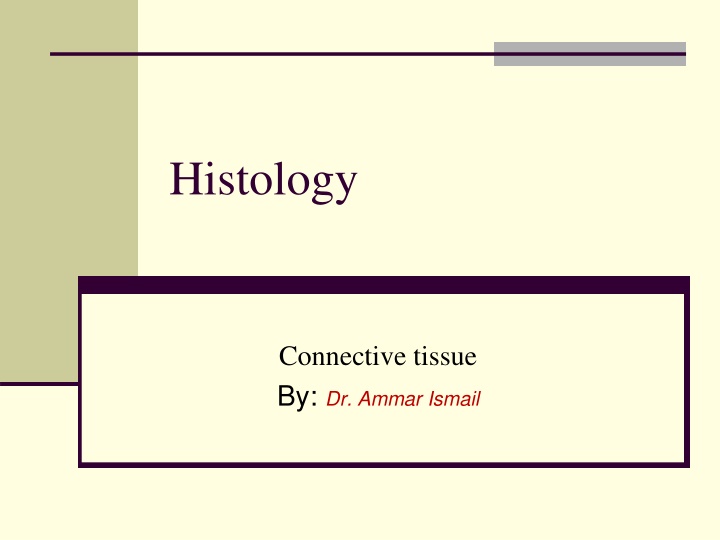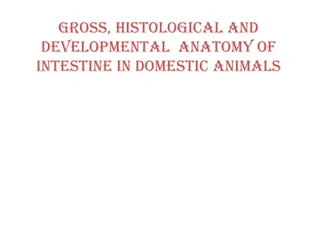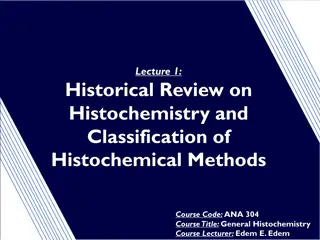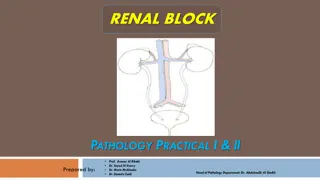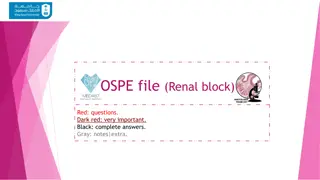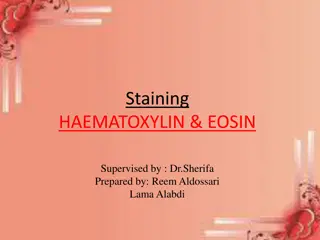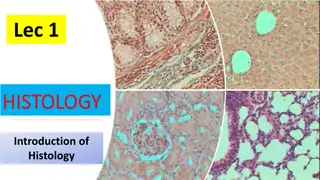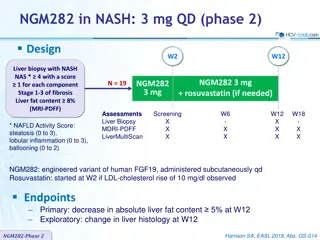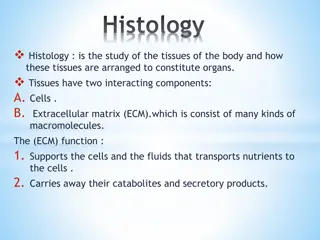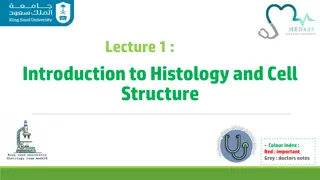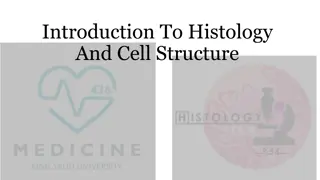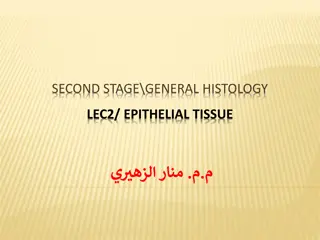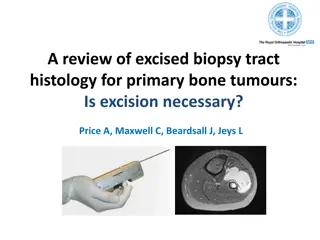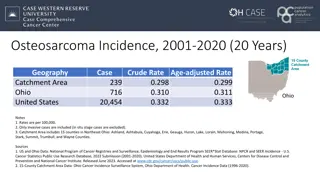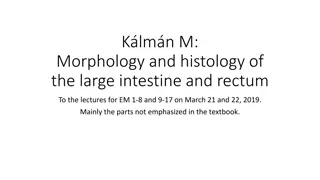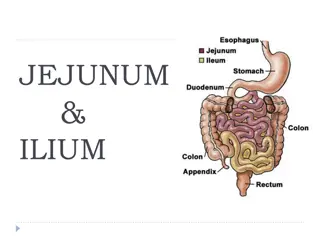Histology
Connective tissue plays a vital role in connecting, supporting, and protecting the body. It consists of cells and extracellular matrix invaded by blood vessels and nerves. The ground substance, composed of mucopolysaccharides like hyaluronic acid, fills the space between cells, while fibers such as collagen, reticular, and elastic provide structural support. Various cell components like fibroblasts, adipose cells, and macrophages contribute to tissue maintenance and repair.
Download Presentation

Please find below an Image/Link to download the presentation.
The content on the website is provided AS IS for your information and personal use only. It may not be sold, licensed, or shared on other websites without obtaining consent from the author.If you encounter any issues during the download, it is possible that the publisher has removed the file from their server.
You are allowed to download the files provided on this website for personal or commercial use, subject to the condition that they are used lawfully. All files are the property of their respective owners.
The content on the website is provided AS IS for your information and personal use only. It may not be sold, licensed, or shared on other websites without obtaining consent from the author.
E N D
Presentation Transcript
Histology Connective tissue By: Dr. Ammar Ismail
Connective tissue The connective tissue have an important function include connection, supporting and also protection. It's composed of cells and extra cellular matrix , the matrix of connective are invaded by blood and enervate by nerves Extra cellular matrix : Composed of ground substance and fibers which resists compressive and stretching forces
Ground substance : It is a complex of highly hydrophilic ,viscous , amorphous ,gel-like material composed of mucopolyssacharid especially hyluronic acid which fill the space between the cells . The ground substance formed from macro molecules of an ionic material have ability of binding large quantities of water with out change its viscosity . The function of ground substance are act as a barrior against the virus and forgin protein , also form a medium through which nutrients and metabolic wastes are exchanged between cells and their blood supply .
Fibers : The connective tissue fibers are formed by proteins that polymerize into elongated structures . there are three main types of connective tissue fibers are collagen , reticular and elastic . 1 Collagen fibers : (White fibers ) A collagenous fibers is formed of a bundle of fibrils , the bundle have a wave form and are branched and units . The fibroblast produce protein molecules ( tropo collagen ) which consider as a fine unit of collagen fiber. In fresh case it appear white color ;therefore ,called white fibers. It is inelastic and possess great tensile strength , it is found in the tendon. 2 Elastic fibers : yellow fibers : Elastic fibers are always single , very thin , branch and re unite frequently . They consist of elastin ( Tropo elastin ) which is a very resistant material . 3 Reticular fibers : These fibers branch and unite to form fine reticulum it is very thin . stained specially by silver ; therefore , some time called argerophil fibers .
Cell components of connective tissue : Fixed cells 1 Fibroblasts . 2 Adipose cells 3 Pericytes. 4 Mast cells 5 Macrophage . 6 Pigmented cells Free cells 1 Plasma cells . 2 Lymphocytes 3 Neutrophiles 4 Eosenophils . 5 Basophiles . 6 Monocytes 7 Macrophages
Fibroblast : Its responsible of produce and secretion the ground substance and fibers . It is derived from undifferentiated mesenchymal cells . The fibroblast is elongated oval or spindle shape have long cytoplasmic processes , with spherical nucleus .
Pericyte: Pericyte is smaller than fibroblast except have long processes . Its surrounded the endothelial cells of capillaries and small venules.
Adipose cells : Are fully differentiated cells that function in the synthesis , storage and release of fat . Adipocytes are large spherical cell , when fill with the fat the nucleus and cytoplasm displaced to the peripherally thus giving these cells a ring shape .
Mast cell It s a largest of fixed cells of connective tissue . they are avoid and possess a centrally placed , spherical nucleus . The characteristic feature of this cells is presence of numerous granules in the cytoplasm which contain heparin , histamine .
Pigmental cells : The cells are oval , large , have process and there cytoplasm have melanin granules , its found in the cornea & retina of eye
Classification of connective tissue : Proper c. t. Embryonic c.t Special c.t. Mesenchymal Mucoidal Dense c. t. Loose Bone cartilage Blood regular irregular areolar spongy hyaline reticular compact elastic Pigmental Fibro adepose
Types of connective tissue Embryonic connective tissue 1 Mesenchymal c.t. : Is present only in the embryo and consist of mesenchymal cells in semi fluid amorphous ground substance containing a fine scattered immature fibers .The mesenchymal cell present an oval nucleus and its cytoplasm have a small processes in several directions . The mesenchymal cell characterized by undifferentiated .
2 Mucoid connective tissue. Is a loose amorphous c.t. exhibiting a jelly like matrix ,consider as a temporal c.t contain cells similar to the mesenchymal cell ,this type have fiber . This tissue also known as Wartons jelly which found only in the Umbilical cord.
Mucoidal connective tissue Umbilical cord Mesenchymal connective tissue Embryo
Connective tissue proper( adult ) : 1 Areolar connective tissue : Its wide spread throughout the body, surrounding vessels and nerves and is found in the serous membrane. This type of connective tissue contain all type of connective tissue cells and fibers.
2 Reticular tissue : The type III collagen is the major fibre forming network with fibroblasts and macrophages. Reticular tissue forms the framework sinusoid, tissue ,bone marrow , lymph node, spleen . interspersed architectural of adipose liver
3 Adipose tissue : It is believed that adipose cells are derived from undifferentiated embryonic stem cells which enrich with blood vessels .also become enlarge after losing of cytoplasmic processes and accumulation of fat droplet .There are two type of adipose tissue : 1 White adipose tissue ( Uni locular ): Each unilocular fat cell contain a single lipid droplet , giving the adipose tissue composed of such cells a white color , it is found subcutaneously , about omentum of abdominal cavity . 2 Brown adipose tissue ( Multi locular ) ; Brown fat is composed of multilocular fat cells which store fat in multiple droplets . This tissue may appear tan to reddish brown because of its extensive vascularity and the cytoplasm present abundant mitochondria ,it is associated with production of body heat because of large number of mitochondria ,therefore , is found in the hibernate animals .The ground substance in both types is little and have only reticular fibers .
Dense connective tissue : Contain most of the same components found in loose c.t. ,except that it has many more fibers and few cells . the orientation and the arrangements of bundles of fibers in this tissue make it resistant to stress . Include : -Dense regular collagenous c. t.: the bundles of collagen fibers may be arranged in row to provide tensile strength in tendons and ligaments . -Dense regular elastic c.t. : the bundles of elastic fibers instead of collagen fibers .nuchal lig. - Dense irregular c. t. : the fibers are arranged in different planes to allow stretching without tearing of the surface membrane as in the dermis and vagina .
